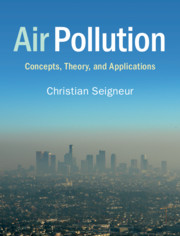Book contents
- Air Pollution
- Air Pollution
- Copyright page
- Contents
- Preface
- Main Notations
- 1 Brief History of Air Pollution
- 2 Emissions of Air Pollutants and Emission Control Technologies
- 3 Meteorology: General Circulation
- 4 Air Pollution Meteorology
- 5 Atmospheric Radiative Transfer and Visibility
- 6 Atmospheric Dispersion
- 7 The Stratospheric Ozone Layer
- 8 Gaseous Pollutants
- 9 Atmospheric Particles
- 10 Clouds and Acid Rain
- 11 Transfer of Pollutants between the Atmosphere and Surfaces
- 12 Health Effects
- 13 Environmental Impacts
- 14 Climate Change and Air Pollution
- 15 Regulations and Public Policies
- Index
- References
9 - Atmospheric Particles
Published online by Cambridge University Press: 19 June 2019
- Air Pollution
- Air Pollution
- Copyright page
- Contents
- Preface
- Main Notations
- 1 Brief History of Air Pollution
- 2 Emissions of Air Pollutants and Emission Control Technologies
- 3 Meteorology: General Circulation
- 4 Air Pollution Meteorology
- 5 Atmospheric Radiative Transfer and Visibility
- 6 Atmospheric Dispersion
- 7 The Stratospheric Ozone Layer
- 8 Gaseous Pollutants
- 9 Atmospheric Particles
- 10 Clouds and Acid Rain
- 11 Transfer of Pollutants between the Atmosphere and Surfaces
- 12 Health Effects
- 13 Environmental Impacts
- 14 Climate Change and Air Pollution
- 15 Regulations and Public Policies
- Index
- References
Summary
Atmospheric particles and, in particular, fine particles are one of the major components of air pollution. They lead to significant adverse health effects, degrade atmospheric visibility, are involved in cloud formation and precipitation, and play a role in climate change. Particles have various sizes, ranging from ultrafine and fine to coarse, and different chemical compositions, since they may contain a large number of different inorganic and organic species. In addition, particles typically include a primary fraction, which has been emitted from various sources directly into the atmosphere, and a secondary fraction, which has been formed in the atmosphere via chemical reactions from precursor gases. The secondary fraction generally dominates the mass of fine particles. Therefore, the development of efficient emission control strategies to decrease the ambient concentrations of atmospheric particles is a challenging task, because it requires identifying the numerous sources of atmospheric particles, including those of the gaseous precursors of the secondary fraction, in order to properly characterize the processes that govern particulate matter (PM) formation and understand the complex relationships that link gaseous precursors and the secondary PM fraction.
- Type
- Chapter
- Information
- Air PollutionConcepts, Theory, and Applications, pp. 190 - 238Publisher: Cambridge University PressPrint publication year: 2019



